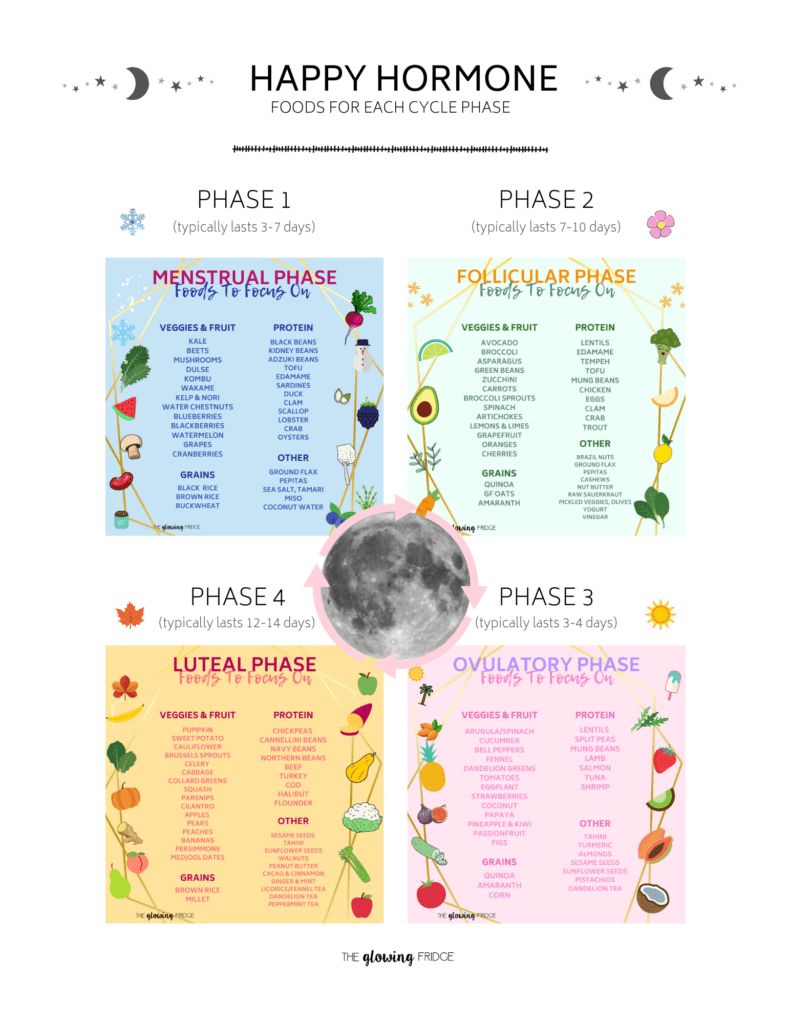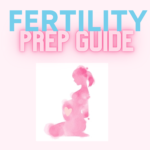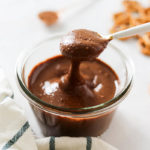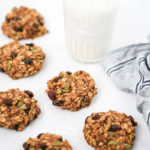
I’ve been wanting to put a post like this together for a long time!
It includes a downloadable food chart for each phase of your menstrual cycle at the end. Throughout this post I have explanations of each phase as well. Throughout my cycle during February, I shared phase-specific plant based food charts with an overview of each cycle phase on instagram (also known as cycle syncing). The reaction was phenomenal! I haven’t found anything else like this, so I’m very excited to have put it together for you. Obviously there will be even more detailed descriptions and recommendations in my book but until then, feel free to refer to these charts!
*** For the cycle syncing food chart, there is a fun freebie (a PDF printout) at the end that you can download, print and hang on your fridge so it’s always on hand. This will make following the phases and corresponding foods SO MUCH EASIER! No need to worry about downloading each picture separately as I have put it all on one convenient page for you.
There are many ways to support your body’s hormonal ecosystem, but food and lifestyle are the pillars for healthy menstrual cycles. Let’s get into The Four Phases of the Menstrual Cycle. and vegan foods for each cycle phase too!
1: MENSTRUAL PHASE (lasts 3-7 days)
The menstrual phase can be considered as the ?winter? season in your body. Consider it a time to rest, conserve energy and hibernate. It is said to be a time when there is little distinction between intuition and logic, allowing you to gain deep access to your inner wisdom and gut feelings. The bleeding phase is naturally cleansing (physically and emotionally) so while you may feel raw and sensitive, you are also letting go of what no longer serves you.
If you do not become pregnant, then 12-14 days after ovulation is when the corpus luteum stops making progesterone and will get reabsorbed in your body. This drop in progesterone is what triggers your uterus to contract and you start your bleed. Day One of your period (and of your cycle) begins on the first day of heavy bleeding. This is great information to know for tracking purposes.
Hormones are now at very low levels which means you have lower energy, your skin is dry and dull, and may appear more red. You may feel more run down than usual but that?s okay because we can?t be ?on? at all times!
Menstrual Phase Foods:
You want to remineralize and restore your blood with food. The foods below are replenishing and rich in minerals like iron and zinc. Focus on miso soups, broths and stews with sea vegetables. Other foods to focus on include water chestnuts, hazelnuts, wild rice, fennel, chlorophyll, adzuki beans and coconut water.
2: FOLLICULAR PHASE (lasts 7-10 days)
The follicular phase is the phase right after your period, when the body prepares to release an egg (also called ovulation). It can also be considered as the ?spring? season in your body.
Each ovary has hundreds of thousands of follicles (sacs of cells containing an immature egg at the center). The pituitary gland is signaled to release FSH (follicle-stimulating hormone) to stimulate a number of follicles to grow (but only one will win!). The maturing follicles release estradiol to thicken the uterine lining for implantation, should the egg become fertilized.
Think new beginnings and trying new things, creativity, happier mood, brain optimization, increased energy and awakening libido!
Follicular Phase Foods:
All of this internal work requires proper nutrients for healthy, maturing follicles. Think lots of healthy fats! The foods listed below contain high levels of vitamin B6, potassium, vitamin A, vitamin C, monounsaturated fats and fiber. Other foods to focus on include olives, asparagus, peas, cherries, plums, pomegranates, nut butter, vinegar-based sauces and dressings, broccoli sprouts and sprouted mung beans. Supplements to consider include zinc, iodine & selenium, vitamin B6 and probiotics.
3: OVULATORY PHASE (lasts 3-4 days)
The ovulatory phase can also be considered as the ?summer? season in your body! This is when the big event of ovulation happens. Typically, you are only fertile for 24 hours in your cycle (when the egg is released), but sperm can live in you for up to 5 days. This is because hey are nourished and kept alive by your fertile cervical mucus (which is a stretchy, egg-white consistency). This is why tracking your cycle, cervical mucus and basal body temperature are super important if you are trying to avoid pregnancy naturally. That way, you can either avoid sex altogether or use protection.
Around day 12 of your cycle, the dominant follicle secretes a surge of estrogen, prompting a flood of luteinizing hormone (LH). This causes the dominant follicle to grow rapidly until around day 14, when the follicle finally ruptures and releases the egg! This is why you may feel a sharp twinge or cramping on one or both sides of your abdomen. Ovulation is a vital part of the menstrual cycle and is the only way your body is able to make progesterone in the next phase (the luteal phase). You are MAGNETIC during ovulation!
Your skin may look extra glowy, the whites of your eyes appear brighter, you may feel more social and talkative, you have lots of energy, your libido is HIGH and you are probably having some great hair days!
Ovulation Phase Foods:
The foods below are cleansing, full of fiber and anti-inflammatory. Now is the time to focus on raw fruits and veggies. Other foods to focus on include cantaloupe, raspberries, guava, fennel, eggplant, okra, turmeric, pistachios and amaranth.
4: LUTEAL PHASE (lasts 12-14 days)
The luteal phase can be considered as the ?fall? season in your body. A time to turn inward, gain clarity and get answers. This is the time to prep for ?winter? and get things done that you?ve been putting off all month. You?ll feel inclined to finish projects, clean out your closet, meal prep and deep clean the house. This is all thanks to progesterone, the calming, anti-anxiety hormone that regulates your mood and promotes deep sleep.
The thing is, in order to make progesterone, you must ovulate (as you learned in the part above). The corpus luteum (what?s left of the follicle after the egg was released) forms into an endocrine gland and starts making progesterone. It is meant to maintain and nourish a pregnancy, should a fertilized egg be implanted. If not, the corpus luteum gets reabsorbed, progesterone plummets and you get your period! It?s an AMAZING process.
This is also the phase when PMS may strike and the hormonal fluctuations may make your skin break out. Lower estrogen levels mean less collagen so your skin may not feel as plump or glowy. Combat this with gentler products and all of the foods above. Do restorative or body resistance exercises instead of high intensity cardio workouts.
Luteal Phase Foods:
The foods on the chart below are warming, detoxifying and grounding. They include plenty of fiber and natural sugars to combat cravings. Other foods to focus on include jicama, garlic, onions, parsnips, jackfruit, persimmons, raisins, dandelion and millet.














Hi! Your IG link is not working and I would like to follow you. What is your @ please xoxo Aurora
Great post! Very informative
Beautiful article! Do you have references for your information? I would love to dive in further.
Hi Long time fan or good healthy food, I am having some difficuties balancing myself after menopause. Your blogs are dedicated to menstuating women, how about us gals who have gotten past that? We suffer from bloating, over weight, sluggishness. If heard the flax seeds have estrogen and are good for a wake up call. What are your ideas? Thanks
I Agree I would love to hear of anything that can help those of us after menopause.
Love this! Thank you for this info graphic summary of the best foods to eat during each phase!